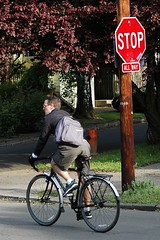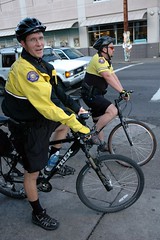Robert Pickett is a member of the Portland Bicycle Advisory Committee, an Alice Award nominee, a regular commenter and contributor to the Forums here on BikePortland.org, and he’s also a police officer in Portland’s Southeast Precinct.
When he’s not working in our community, he likes to ride tall bikes.
In the article below, Officer Pickett clarifies the age-old question of whether or not you’ve got to put your foot down at a stop sign. As a bonus, he also uncovers some important info about yellow lights you might not have been aware of.
One of the most common questions I hear about bicycle-related traffic law is whether or not a person riding a bicycle is required to put their foot on the ground when stopping at a stop sign.
Oregon law specifically describes the proper response to various traffic control devices (stop signs, yield signs, traffic lights, etc.). The wording is too long to include in the text (though here’s a link—scroll down to ORS 811.260), but the key phrase that describes appropriate vehicle operator behavior when confronted by a stop sign, flashing red signal or solid red signal is “shall stop.” (And yes, in this and most other Oregon traffic laws, bicycles are considered “vehicles.”)
The statute also mentions where you should stop (generally before the crosswalk, marked or unmarked) and when you can start again (after yielding right of way). Nowhere in the law is there mention of putting your foot down if you are riding a bicycle or motorcycle.
If your tires stop rolling forward, have you stopped? Most people, including most judges and officers, would say yes. Are some bicycle riders able to stop their tires from rolling forward and then start up again without putting their feet down? Yes.
“Nowhere in the law is there mention of putting your foot down if you are riding a bicycle…”
That said, if an officer happened to be watching you from a ways away, would putting your foot down be a good indication that you probably stopped completely? Yes. However, will most officers position themselves so they have a good view of the tires or front of the vehicle so they don’t have to enter into a did-he-stop-or-not-stop argument to begin with? Also yes.
Another common misunderstanding of Oregon traffic statutes is what to do at yellow lights.
In most other states, a yellow light is simply a warning to drivers that the light will soon turn to red:
From the California Vehicle Code:
A driver facing a steady circular yellow or yellow arrow signal is, by that signal, warned that the related green movement is ending or that a red indication will be shown immediately thereafter….
From the Washington Vehicle Code:
Vehicle operators facing a steady circular yellow or yellow arrow signal are thereby warned that the related green movement is being terminated or that a red indication will be exhibited immediately thereafter when vehicular traffic shall not enter the intersection….
The Oregon statute, however, says that not only is the yellow light a warning, but that vehicle operators must stop at a yellow light, with the only justification for not stopping being that it would be unsafe to do so:
A driver facing a steady circular yellow signal light is thereby warned that the related right of way is being terminated and that a red or flashing red light will be shown immediately. A driver facing the light shall stop at a clearly marked stop line, but if none, shall stop before entering the marked crosswalk on the near side of the intersection, or if there is no marked crosswalk, then before entering the intersection. If a driver cannot stop in safety, the driver may drive cautiously through the intersection.
What would prevent one from stopping safely? Someone else following too closely perhaps? Maybe an icy road? That is up to a citation recipient to argue and a judge to decide! The gist is that in Oregon, except for a few exceptions, a yellow light should generally be treated the same as a red one.
Lastly, what about all those intersections in residential areas without any stop or yield signs at all, otherwise known as “uncontrolled” intersections? Oregon Revised Statute 811.275 says that you have to yield to any vehicle approaching from the right, even if you arrive at the intersection before that other vehicle. However, 811.277 stipulates that if it is an uncontrolled T-intersection, and yours is the road that is ending, you have to yield to traffic approaching from both directions.
Clear and simple, huh!
For more exciting reading, check out the Oregon Vehicle Code.
— by Officer Robert Pickett, Portland Police Bureau
More Guest Articles by Robert Pickett:




